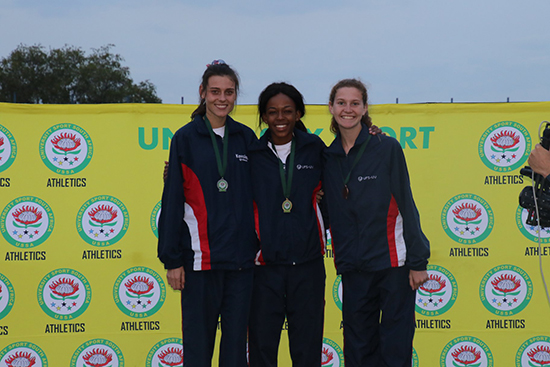Latest News Archive
Please select Category, Year, and then Month to display items
04 May 2018
Photo Facebook
 From left: Marné Mentz (second), Ts’epang Sello (first) and Tyler Beling (third) were in a class of their own, taking the first three spots in the 1 500m at the University Sport South Africa national championship in Sasolburg.
From left: Marné Mentz (second), Ts’epang Sello (first) and Tyler Beling (third) were in a class of their own, taking the first three spots in the 1 500m at the University Sport South Africa national championship in Sasolburg.
As expected, the Kovsie athletics team made the University Sport South Africa (USSA) national championship, held over the weekend in Sasolburg, one to remember.
Eight athletes earned gold medals, which is twice as many as last year. The total of 24 medals (including seven silver and nine bronze) is also double the number won in 2017.
They ended third, just one gold medal below the University of Johannesburg. The female athletes won the women’s competition and contributed to seven of the eight gold medals. The Kovsies dominated the 1 500m and 5 000m events in which they both claimed the first, second and third spots. They even grabbed the fourth and sixth position in the 5 000m in which Kesa Molotsane triumphed, with Tyler Beling second, and Marné Mentz third. Mentz and Beling swapped places in the 1 500m behind Ts’epang Sello.
Molotsane also won the 10 000m in a record time of 34:49.16 which is a massive three minutes and five seconds quicker than the previous record.
The 800m title also now belongs to Sello. She and Beling won a third medal (bronze) as members of the 4 x 400m relay women’s team.
The other gold medalist was Lara Orrock (3 000m steeplechase), Lynique Beneke (long jump), Esli Lamley (pole vault) and Rynardt van Rensburg (800m).
All five Kovsies who competed at the CAA Southern Region Youth & Junior Championships that took place over the weekend in Boksburg, won medals. They were Pakiso Mthembu (gold, 5 000m), Michaéla Wright (gold, long jump), Tyler (gold, 1 500m), Tsebo Matsoso (silver, 200m) and Orrock (silver, 3 000m steeplechase).
Haemophilia home infusion workshop
2017-12-17

Parents receive training for homecare of their children with haemophilia.
Photo Supplied
Caregivers for haemophilia patients, and patients themselves from around the Free State and Northern Cape attended a home infusion workshop held by the Clinical Skills unit in the Faculty of Health Sciences in July 2017. “It felt liberating and I feel confident to give the factor to my son correctly,” said Amanda Chaba-Okeke, the mother of a young patient, at the workshop. Her son, also at the workshop, agreed. “It felt lovely and good to learn how to administer factor VIII.”
Clinical skills to empower parents and communities
There were two concurrent sessions: one attended by doctors from the Haemophilia Treatment Centre, and the other attended by community members including factor VIII and XI recipients, caregivers and parents. The doctors’ meeting was shown informative videos and demonstrations on how to administer the newly devised factor VII and XI kit, and discussed the pressing need for trained nurses at local clinics. Dr Jaco Joubert, a haematologist, made an educational presentation to the community members.
The South African Haemophilia Foundation was represented by Mahlomola Sewolane, who gave a brief talk about the role of the organisation in relation to the condition. Meanwhile, procedural training in the simulation laboratory involved doctors and nurses helping participants to learn the procedures by using mannequins and even some volunteers from among the patients.
A medical condition causing serious complications
Haemophilia is a medical condition in which the ability of the blood to clot is severely impaired, even from a slight injury. The condition is typically caused by a hereditary lack of a coagulation factor, most often factor VIII. Usually patients must go through replacement therapy in which concentrates of clotting factor VIII (for haemophilia A) or clotting factor IX (for haemophilia B) are slowly dripped or injected into the vein, to help replace the clotting factor that is missing or low. Patients have to receive this treatment in hospital.